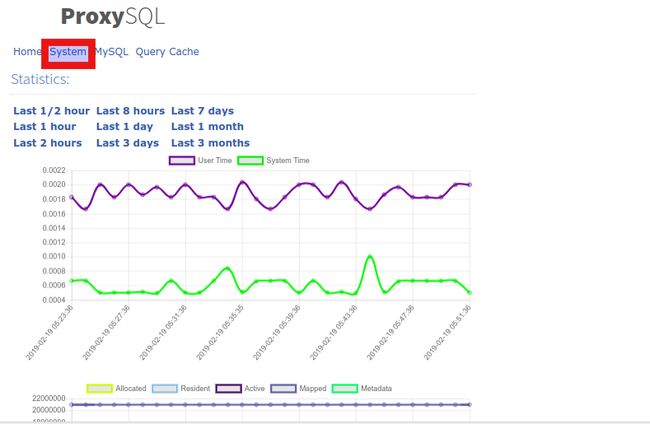ProxySQL 配置详解及读写分离(+GTID)等功能说明 (完整篇)2
|
|
4. 安装配置ProxySQL
已经在上面第一步中介绍了安装方法,这里采用rpm包方式安装,安装过程省略........
4.1 ProxySQL实现读写分离
向ProxySQL中添加MySQL节点
| 1 2 3 4 5 6 7 8 9 10 11 12 13 14 15 16 17 18 19 20 21 22 23 24 25 26 27 28 29 30 31 32 33 34 35 36 37 38 39 40 41 42 43 44 45 46 47 48 49 50 51 52 53 54 55 56 57 58 59 60 61 62 63 64 65 66 67 68 69 70 71 |
|
监控后端MySQL节点
添加Mysql节点之后,还需要监控这些后端节点。对于后端是主从复制的环境来说,这是必须的,因为ProxySQL需要通过每个节点的read_only值来自动调整
它们是属于读组还是写组。
首先在后端master主数据节点上创建一个用于监控的用户名(只需在master上创建即可,因为会复制到slave上),这个用户名只需具有USAGE权限即可。如果还需
要监控复制结构中slave是否严重延迟于master(这个俗语叫做"拖后腿",术语叫做"replication lag"),则还需具备replication client权限。
| 1 2 3 4 5 6 7 8 9 10 11 12 13 14 15 16 17 18 19 20 21 22 23 24 25 26 27 28 29 30 31 32 33 34 35 36 37 38 39 40 41 42 43 44 45 46 47 48 49 50 51 52 53 54 55 56 57 58 59 60 61 62 63 64 65 66 67 68 69 70 71 72 73 74 75 76 77 78 79 80 81 82 83 84 85 86 87 88 89 90 91 92 93 94 95 96 97 98 99 100 101 102 103 104 105 106 107 108 109 110 111 112 113 114 115 116 117 |
|
配置mysql_users
上面的所有配置都是关于后端MySQL节点的,现在可以配置关于SQL语句的,包括:发送SQL语句的用户、SQL语句的路由规则、SQL查询的缓存、SQL语句的重写等等。本小节是SQL请求所使用的用户配置,例如root用户。这要求我们需要先在后端MySQL节点添加好相关用户。这里以root和sqlsender两个用户名为例.
| 1 2 3 4 5 6 7 8 9 10 11 12 13 14 15 16 17 18 19 20 21 22 23 24 25 26 27 28 29 30 31 32 33 34 35 36 37 38 39 40 41 42 43 44 45 46 47 48 49 50 51 52 53 54 55 56 57 58 59 60 61 62 63 64 65 66 67 68 69 70 71 72 73 74 75 76 77 78 79 80 81 82 83 84 85 86 87 88 89 90 91 92 93 94 95 96 97 98 99 100 101 102 103 104 105 106 107 108 109 110 111 112 113 114 115 116 117 118 119 120 121 122 123 124 125 126 127 128 129 |
|
读写分离:配置路由规则
ProxySQL的路由规则非常灵活,可以基于用户、基于schema以及基于每个语句实现路由规则的定制。本案例作为一个入门配置,实现一个最简单的语句级路由规则,从而实现读写分离。
必须注意: 这只是实验,实际的路由规则绝不应该仅根据所谓的读、写操作进行分离,而是从各项指标中找出压力大、执行频繁的语句单独写规则、做缓存等等。和查询规则有关的表有两个:mysql_query_rules和mysql_query_rules_fast_routing,后者是前者的扩展表,1.4.7之后才支持该快速路由表。本案例只介绍第一个表。插入两个规则,目的是将select语句分离到hostgroup_id=20的读组,但由于select语句中有一个特殊语句SELECT...FOR UPDATE它会申请写锁,所以应该路由到hostgroup_id=10的写组.
| 1 2 3 4 5 6 7 8 9 10 11 12 13 14 15 16 17 18 19 20 21 22 23 24 25 26 27 28 29 30 31 32 33 34 35 36 37 38 39 40 41 42 43 44 45 46 47 48 49 50 51 52 53 54 55 56 57 58 59 60 61 62 63 64 65 66 67 68 69 70 71 72 73 74 75 76 77 78 79 |
|
测试读写分离效果
| 1 2 3 4 5 6 7 8 9 10 11 12 13 14 15 16 17 18 19 20 21 22 23 24 25 26 27 28 29 30 31 32 33 34 35 36 37 38 39 40 41 42 43 44 45 46 47 48 49 50 51 52 53 54 55 56 57 58 59 60 61 62 63 64 65 66 67 68 69 70 71 72 73 74 75 76 77 |
|
4.2 负载均衡测试 (加权轮询)
如上已经配置好一主(mysql-master,在hostgroup10写组内)、两从(mysql-slave1和mysql-slave2,在hostgroup20读组内) ,并且已经在"mysql_query_rules"表中配置了路由规则,即写操作转发到hostgroup10组,读操作转发到hostgroup20组.
| 1 2 3 4 5 6 7 8 9 10 11 12 13 14 15 16 17 18 19 20 21 22 23 24 25 26 27 28 29 30 31 32 33 34 35 36 37 38 39 40 41 42 43 44 45 46 47 48 49 50 51 52 53 54 55 56 57 58 59 60 61 62 63 64 65 66 67 68 69 70 71 72 73 74 75 76 77 78 79 80 81 82 83 84 85 86 87 88 89 90 91 92 93 94 95 96 97 98 99 100 101 102 103 104 105 106 107 108 109 110 111 112 113 114 115 116 117 118 119 120 121 122 123 124 125 126 127 128 129 130 131 132 133 134 135 136 137 138 139 140 141 142 143 144 145 146 147 148 149 150 151 152 153 154 155 156 157 158 159 160 161 162 163 164 165 166 167 |
|
4.3 开启ProxySQL的Web统计功能
| 1 2 3 4 5 6 7 8 9 10 11 12 13 14 15 16 17 18 19 20 21 22 23 24 25 26 27 28 |
|
查看web端口是否正常打开
| 1 2 3 |
|
访问http://172.16.60.214:6080并使用stats:stats登录即可查看一些统计信息。
4.4 scheduler打印proxysql状态到日志
| 1 2 3 4 5 6 7 8 9 10 11 12 13 14 15 16 17 18 19 20 21 22 23 24 25 26 27 |
|
***************当你发现自己的才华撑不起野心时,就请安静下来学习吧***************
